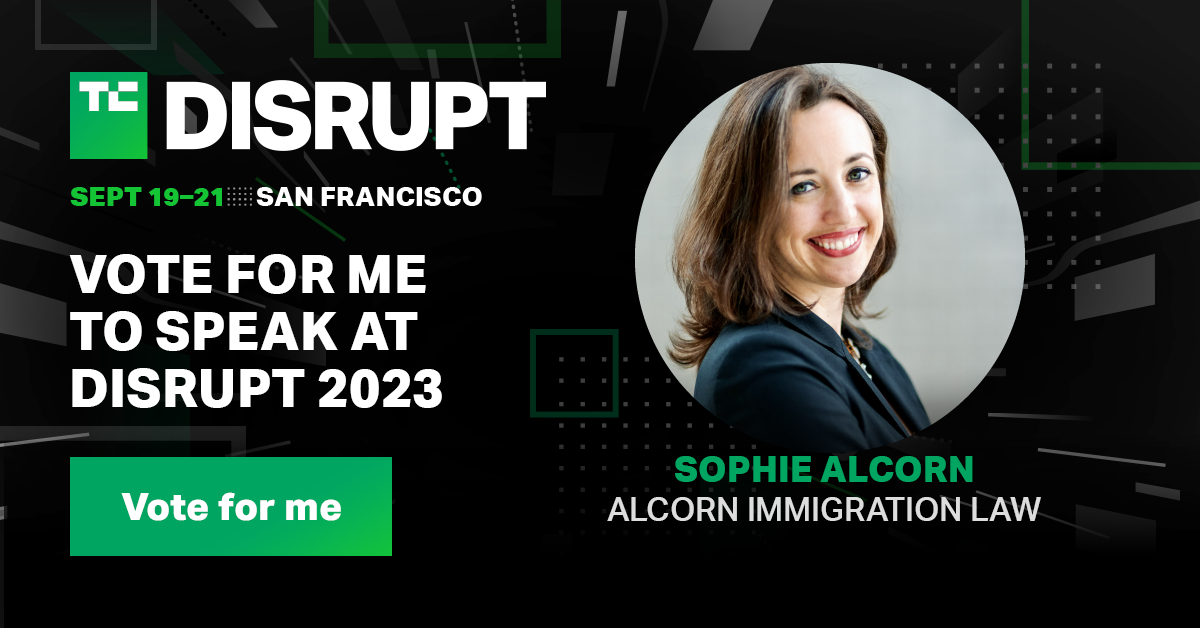Here’s another edition of “Ask Sophie,” the advice column that answers immigration-related questions about working at technology companies.
“Your questions are vital to the spread of knowledge that allows people all over the world to rise above borders and pursue their dreams,” says Sophie Alcorn, a Silicon Valley immigration attorney. “Whether you’re in people ops, a founder or seeking a job in Silicon Valley, I would love to answer your questions in my next column.”
TechCrunch+ members receive access to weekly “Ask Sophie” columns; use promo code ALCORN to purchase a one- or two-year subscription for 50% off.
Dear Sophie,
What do you think about applying for an EB-1A straight away without first using the O-1A as a stepping stone?
Thanks!
— Extraordinary Engineer in Escondido
Dear Extraordinary,
Yes, it’s definitely possible to apply for an EB-1A extraordinary ability green card without first using the O-1A extraordinary ability visa as a stepping stone! Allow me to give you some context so that you can think about whether this path could be best for you.
In general, O-1A visa holders typically have an easier time getting an EB-1A compared to people who are currently outside the U.S. or those with another type of immigration status in the U.S. such as an H-1B. To hear more about the EB-1A requirements, check out my podcast on Extraordinary Ability Bootcamp.
This is simply because the eligibility requirements for the O-1A and EB-1A overlap and those who have gone through the exercise of preparing an O-1A visa have already gathered a tremendous amount of paperwork and letters of recommendation evidencing their success.
However, I know from personal experience that many individuals can go directly to an EB-1A green card while they were on visas other than the O-1A, or even outside the United States. That means the EB-1A is possible for individuals currently working temporarily in the U.S. on visas such as the E-2 treaty investor visa, the E-3 visa for Australian professionals, the H-1B specialty occupation visa, L-1 multinational transferees and the TN (Treaty National) visa for Canadian and Mexican professionals.
Please keep in mind that if you are traveling on a visa that requires nonimmigrant intent (such as an F-1 or B-1/B-2), going straight for an EB-1A could be a blocker to subsequent U.S. entries, because it would be your burden at entry to demonstrate to immigration officials abroad and at U.S. ports of entry that you intend to eventually return to your home country. Starting a green card process (especially by self-petitioning an I-140 in the EB-1A category) is likely to be considered strong evidence of immigrant intent.
The ultimate “golden ticket”
Because the EB-1A green card is a first-priority employment-based green card, the wait time for this green card category is typically the shortest compared to other employment-based green cards.
According to the Visa Bulletin for May 2023, the EB-1 category is the only one that has green card numbers currently available for all countries except China and India. Both the U.S. Department of State, which oversees consular processing outside the U.S., and U.S. Citizenship and Immigration Services (USCIS), which adjudicates visa and green card applications and oversees the process within the U.S. Most of the time, the Visa Bulletin issued by the State Department mirrors the one issued by USCIS.
In the latest bulletin, the State Department noted that the EB-1 dates for China and India will likely retrogress from Feb. 1, 2022, shortly. That means the wait time for individuals born in China and India will likely get longer. Click here for more info about how to read the Visa Bulletin.
Besides being the fastest employment-based green card path, another benefit of the EB-1A is that it is one of only two employment-based green cards — the other being the EB-2 NIW (National Interest Waiver) — that you can apply for on your own without an employer sponsor. Self-petitioning allows an individual of extraordinary ability to request green cards for themselves, spouses and children without waiting on a job offer and grant of sponsorship from a U.S. employer.
How to level up
To get started with exploring your EB-1A, I recommend working with an immigration attorney to assess your qualifications and make sure that this path makes sense for you. You can also work together to identify ways to build up your accomplishments or look for a short-term alternative if necessary.
Once you begin the EB-1A, your attorney will help you craft a strong petition and guide you through the green card application process. An immigration attorney can also help you ensure you remain in valid status while you apply and wait for your green card approval, as well as adjust your status from your current visa to permanent residence when your priority date becomes current.
Applying for an EB-1A green card requires submitting Form I-140, the application for permanent residence, and Form I-485, which is called the Application to Register Permanent Residence or Adjust Status, to U.S. Citizenship and Immigration Services (USCIS). If you were born in a country other than China or India and your EB-1A petition is ready, then you can submit both forms together to USCIS since green card numbers are available for you. (In the Visa Bulletin, green card categories that are marked with a “C,” means that green card numbers are currently available.)
However, if you were born in China or India, you must wait for a green card number to become available before you can submit Form I-485. Or, if you have a preexisting priority date from another green card process, you might be able to utilize that: Your priority date is the date that USCIS received your green card application. If it is on or before the date listed in the green card category you are applying for and your country of birth (or your spouse’s country of birth, called cross-chargeability), then a green card number is available, and you can submit your I-485.
You can file Form I-140 with premium processing, which means USCIS will decide on your application for permanent residence within 15 days. Without premium processing, USCIS can take 15 months or more to process an EB-1A I-140. However, premium processing is not available for the I-485. Getting an EB-1A green card takes about a year and it can involve an in-person Adjustment of Status interview.
From average to extraordinary
You will want to allocate your time wisely as you build your qualifications for EB-1A extraordinary ability green card. Keep in mind that you’re trying to demonstrate to USCIS that you are at the top of your field or subfield in a country or in the world. First, your attorney will help you define your field, and a narrow definition is usually more helpful than a broad definition. If your field is defined too broadly, you may have difficulty proving that you are among the top.
For the EB-1A, you must meet at least three of 10 criteria. Keep in mind that some of your accomplishments may fulfill more than one criterion. Here is my founder-oriented interpretation of the law laying out the 10 criteria:
- Nationally or internationally recognized post-university, professional-level awards, such as securing VC funding, acceptance into an accelerator or incubator program, winning a startup pitch competition or hackathon, or presenting at a professional association or conference.
- Exclusive, invitation-only membership in organizations with stringent selection criteria and a low selection rate, such as being accepted into an accelerator or incubator program or selected as an adviser or mentor at an accelerator or incubator program.
- Authoring newspaper or magazine articles that have been published in professional trade publications, scientific or scholarly journals, or other major media.
- You or your work have been profiled or featured in professional trade publications, major media or scholarly journals.
- Judging the work of others in your field or a related field individually or on a panel, such as at a hackathon or pitch competition or being a Venture Scout.
- You have made original contributions of major significance to your field as shown through coverage in media publications, your publications have been widely cited or your work is used by others through contracts with companies, licensed technology or patents.
- Your work has been displayed at artistic exhibitions or showcases, which primarily applies to UX/UI designers in tech.
- You perform a leading or critical role at your company, such as a project manager or a product development lead.
- You command a high salary compared to others in the field, ideally in the top 10% of salaries in the field for your role, level and geography, which can include the valuation of any equity in a company.
- You have commercial successes in the performing arts.
While you technically only need to meet three of the criteria to qualify for the EB-1A, I recommend meeting four or more to present a strong case, and an EB-1A works best when you have a strong track record demonstrating sustained national or international acclaim over time.
All the best to you on your extraordinary green card journey! Enjoy the ride!
— Sophie
Have a question for Sophie? Ask it here. We reserve the right to edit your submission for clarity and/or space.
Sophie Alcorn, founder of Alcorn Immigration Law in Silicon Valley, CA, is an award-winning Certified Specialist Attorney in Immigration and Nationality Law by the State Bar Board of Legal Specialization. Sophie is passionate about transcending borders, expanding opportunity, and connecting the world by practicing compassionate, visionary, and expert immigration law. Connect with Sophie on LinkedIn and Twitter.
Sophie’s podcast, Immigration Law for Tech Startups, is available on all major platforms. If you’d like to be a guest, she’s accepting applications!

